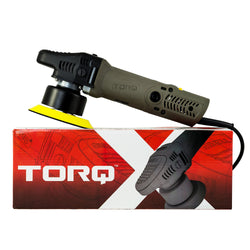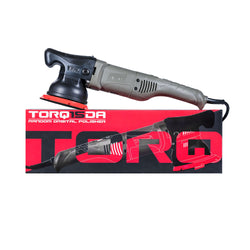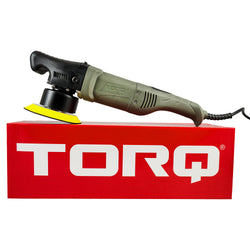| Exterior How-To's | |
| Interior How-To's | |
| Drying How-To's | |
| Latest Innovations | |
| Ceramic How-To's | |
| Detailing University |
Polishing your car is like giving it a high-stakes makeover montage. Done right, it smooths out the rough patches and hides those minor scars—scratches and dents become a distant memory. Water spots and acid rain? They vanish like magic. It’s all about getting that showroom sparkle, with polish and wax teaming up like a dynamic duo of beauty and bling.
Enter the buffer, the tool that’s either a detailing savior or your car's worst nightmare. It lures you in with promises of transforming dull paint into something that could star in a Hollywood blockbuster. But handle it wrong and you could turn your detailing session into a slapstick comedy of errors. No wonder many folks prefer the old-fashioned hand polish—it’s less likely to turn your car into a tragic comedy.
Choosing the right machine polisher is like picking the right costume for your car’s big debut. Get it right, and your ride will be the belle of the ball, turning heads and dropping jaws.
Understanding Car Polisher Specs

Confused about OPM and throw? No worries, we’ve got you covered with this snappy guide to car polisher specs:
OPM/RPM: Think of this as your polisher’s dance moves. Dual-action polishers shimmy with oscillations per minute (OPM), while rotary polishers bust a spin with rotations per minute (RPM). It’s basically how fast the pad is getting its groove on.
POWER: This is the wattage, or how much muscle your polisher packs. Higher wattage means more torque, which translates to “more oomph” for handling those tough jobs. It’s like comparing a featherweight boxer to a heavyweight champ.
BACKING PLATE DIAMETER: The size of the backing plate is your polisher’s version of shoe size. Bigger plates cover more ground, but they might trip you up in tight spots. It’s like choosing between a big, comfy SUV and a zippy little sports car.
THROW: For dual-action polishers, this is how much the pad swings out from the center, like how much your dance partner twirls you around. A longer throw means you can polish faster by covering more surface area—think of it as turbo mode for your car’s shine.
ERGONOMICS AND WEIGHT: This is not on the original list but is worth mentioning. A polisher that doesn’t feel like you’re wielding a medieval weapon will make your detailing sessions less of a workout and more of a groove.
So, polishing your car is an art form with the right tool. Choose wisely, and you’ll turn your ride from "meh" to "whoa!" faster than you can say “car detailing guru.”
Dual Action (DA Polisher) vs Rotary Car Polishers
Chemical Guys serve up two kinds of polishers: the dual action random orbital polishers and the rotary polishers. It’s like choosing between a chill, smooth-talking DJ and a high-energy rave DJ for your car’s detailing party.
Dual action polishers are like that friend who’s all about keeping things cool and casual, spinning in random patterns to make sure your car gets an even shine without turning you into a sweaty mess. They’re great for those who want to avoid any detailing disasters and keep things on the up and up.
On the other hand, rotary polishers are the high-octane rock stars of the polishing world. They spin like they’re in a perpetual concert, delivering a powerhouse shine but requiring a bit more finesse to avoid any polish-induced chaos. They’re perfect for when you need serious shine and are ready to rock out with your detailing gloves out.
So, whether you’re in the mood for a smooth groove or an all-out polishing jam session, Chemical Guys has the polisher to match your detailing vibe!

ROTARY POLISHER
- Spins on One Axis: The buffer head on a direct drive polisher spins on a single axis, meaning it’s a no-nonsense, straight-up spinning action. Think of it as the polisher's way of saying, “I don’t do fancy moves, I just get the job done.”
- High-Speed Machine: These bad boys are all about speed. They whip up a storm of polishing power, making them the go-to choice when you need to get serious about that shine.
- Generates High Correction Heat: They generate a lot of heat in one spot. This is great for tackling deep scratches and swirl marks, but it’s a bit like putting your car through a hot yoga class—intense, but effective.
- Heavy Duty Correction: Perfect for those heavy-duty jobs where your car’s paint looks like it’s been through a war zone. If your ride has seen better days and needs some major TLC, this is your tool.
- No Safety Features: These polishing machines are straight shooters with no built-in safety nets. They’ll spin whether you’re ready or not, so it’s essential to handle them with care—or risk turning your detailing session into a high-speed dance with disaster.
In short, direct drive polishers are the heavyweight champions of the polishing world, built for serious correction and unflinching performance. Just remember, with great power comes great responsibility!

DUAL ACTION POLISHER
- Dual-Axis Spin: Imagine a polisher doing the cha-cha—its head spins on one axis while the entire head rotates on another. It’s like having a dance partner who’s always in sync, ensuring even coverage with every move.
- Moderate Heat and Correction Power: These polishers generate just the right amount of heat—not enough to roast marshmallows but enough to tackle moderate corrections. They’re perfect for making those paint imperfections vanish without turning your car into a sauna.
- Versatile Abilities: They’re the jack-of-all-trades for detailing. Whether you need to polish paint, scrub carpets, spread wax/glaze/sealant, decontaminate paintwork, or restore headlights, this tool’s got you covered. It’s like having a detailing toolbox on a stick!
- Built-in Safety Features: Designed with safety in mind, these polishers come with features that keep both newbies and pros out of trouble. They’re like having training wheels on your detailing bike—helping you stay balanced and avoid any mishaps.
In a nutshell, dual-action polishers are your go-to for a wide range of detailing tasks, combining versatility with a touch of safety. It’s the perfect tool for when you want to be a detailing rockstar without the risk of stage diving into disaster!
Alright, you’re ready to dive into the world of car polishers! Now that you’ve got the lowdown on rotary versus dual-action orbital, let’s break down what else you need to think about to pick your perfect polisher:
Skill Level: Think of your detailing skills as your polisher’s dance partner. If you’re just learning the steps, go for a user-friendly buffer that won’t turn you into a detail disaster. Advanced polishers are like expert-level moves—powerful but potentially paint-damaging if you don’t know your stuff.
Type of Buffer: It’s like choosing your weapon of choice in a video game:
- Orbital Buffers: The beginner’s trusty sidekick—easy to use and hard to mess up.
- Rotary Buffers: The heavy-hitter that requires a bit of finesse to avoid turning your paint job into a modern art experiment.
- Dual-Action Buffers: The balanced hero—offering both safety and efficiency, perfect for most detailing quests.
- Forced-Rotation Buffers: The paint correction beast—ideal for serious touch-ups, but handle with care!
Power and Speed Control: Look for a polisher with variable speed settings. It’s like having a gear shift for your car detailing—different jobs need different speeds, so being able to adjust lets you switch from a gentle polish to a high-speed shine with ease.
Size of the Buffer: Size matters! Larger pads cover more ground quickly, but might struggle in tight corners—think of them as the bulldozer of polishers. Smaller pads are the precision tools for those tricky spots—perfect for when you need to get into the detailing nooks and crannies.
Budget: Set a budget that suits your needs and wallet. Polishers come in all price ranges—from budget-friendly options that won’t break the bank to top-of-the-line models for the pros. Balance what you need with what you’re willing to spend, and you’ll find the perfect polisher for your detailing adventure.
In summary, choosing the right polisher is all about finding the tool that fits your skill level, detailing tasks, and budget. It’s like picking the perfect sidekick for your car’s shine journey—make the right choice, and you’ll be cruising to a show-ready finish in no time!
Orbital Car Polishers
But don’t worry—if you’re feeling overwhelmed by the world of polishers, there's a hero in the detailing realm: the orbital polisher. So, what sets it apart from the rotary and other types? Let’s break it down:
Orbital Polishers: Think of these as the friendly neighborhood heroes of the polishing world. Unlike the rotary polisher, which spins like a top and can be a bit temperamental if you're not careful, the orbital polisher uses a random orbit motion. This means it rotates in a pattern that’s not directly linked to the spinning of the pad, making it less likely to burn through the paint or leave unsightly swirl marks. This randomness makes it a great choice for beginners and anyone who wants to avoid turning their vehicle into a canvas of imperfections.
Safety and Ease of Use: Orbital polishers are much safer for vehicle paint compared to rotary polishers. They won’t burn through your paint or clear coat, which is particularly important for darker-colored vehicles where flaws are more visible. With an orbital polisher, you don’t have to tiptoe around your car like it’s made of glass.
Efficiency and Cost-Effectiveness: Using an orbital polisher saves you time and money. Unlike hand polishing, where it’s easy to overapply product, an orbital polisher helps you apply a thin, even coat, ensuring you use less product. This efficiency can cut your labor time in half and save you from buying excessive amounts of polish.
Better Results with Less Effort: Orbital polishers outperform hand polishing and rotary devices in terms of results. Today’s clear-coat paints are prone to scratches, making hand polishing a delicate task. With an orbital polisher, you can apply a bit more pressure and get better results without risking damage to the paint. This tool offers a safer, more effective way to achieve a showroom-quality shine and handle minor imperfections.
In essence, orbital polishers blend safety, efficiency, and ease of use, making them a solid choice for anyone looking to enhance their vehicle’s appearance without the hassle of more complex or risky tools. They’re your go-to for a great finish with a lot less worry about paint damage or excessive elbow grease!
Best Beginner Small to Medium Vehicles
TORQX RANDOM ORBITAL POLISHER
The TORQX is the go-to dual-action polisher for anyone from greenhorns to detailing veterans and pros alike. It’s the perfect blend of simplicity, lightweight design, and powerhouse performance—all packed into one versatile machine that handles it all with ease.
- TYPE: Dual Action / Random Orbital 120V
- OPM: 1,200-4,200
- POWER: 700W
- BACKING PLATE: 5"
- THROW: 8mm
- WEIGHT: 6.5lbs
Best Intermediate/Professional Polisher
TORQ15DA LONG-THROW RANDOM ORBITAL POLISHER
The TORQ15DA is the long throw dual action polisher that quickly and easily removes scratches and swirls to get your paint back to a mirror-like shine with minimal fatigue and maximum comfort.
- TYPE: Dual Action / Random Orbital 120V
- OPM: 1,800-5,500
- POWER: 900W
- BACKING PLATE: 5"
- THROW: 15mm
- WEIGHT: 6.9lbs
Best for Polishing Regularly

TORQ10FX RANDOM ORBITAL POLISHER
The TORQ10FX is like the Swiss Army knife of polishers—powerful enough for pros, comfy enough for enthusiasts. It’s got all the right moves, from adjustable speeds to ergonomic design, making your car shine like it’s auditioning for a Hollywood role. Whether you’re a detailing guru or just want to look like one, the TORQ10FX has your back!
- TYPE: Dual Action / Random Orbital 120V
- OPM: 1,500-4,200
- POWER: 700W
- BACKING PLATE: 5"
- THROW: 8mm
- WEIGHT: 6.5lbs
Best Polisher for Heavy Paint Neglect

TORQ R ROTARY POLISHER
The TORQ R is like the lovechild of sleek industrial design and next-gen polishing tech. It’s got the looks and the muscle, bringing together cutting-edge technology with a modern twist. If you want your car to look like it’s been polished by a futuristic robot, the TORQ R is your go-to!
- TYPE: Rotary 120V
- RPM: 600-2,400
- POWER: 900W
- BACKING PLATE: 5"
- THROW: 8mm
- WEIGHT: 6.5lbs
Best Polisher for Boats, RVs & Trucks

TORQ22D RANDOM ORBITAL POLISHER
The TORQ22D is a high-tech wonder that makes detailing a breeze. It’s got a massive 21mm throw for top-notch performance, plus the smoothest operation and most comfortable grip around. It’s like having a detailing genie—just with fewer wishes and more polish!
- TYPE: Dual Action / Random Orbital 120V
- OPM: 1,700-4,300
- POWER: 900W
- BACKING PLATE: 6"
- THROW: 21mm
- WEIGHT: 6.85lbs
Common Questions about Car Polishers
How often should I use a buffer on my car?
The frequency of buffering depends on your car’s paint condition and your detailing goals. Buffing once or twice a year for general maintenance is the most common usage. However, more frequent use might be necessary for certain concerns, such as scratches, swirl marks, or tree sap.
What types of pads should I use with a car buffer?
The type of pad depends on the task. Foam pads are commonly used for polishing, while microfiber pads are suitable for applying wax or sealants.
How do I choose the correct pads for my buffer?
Pads vary in material (foam, wool, microfiber) and purpose (polishing, waxing). Choosing a softer foam pad for polishing and firmer pads for waxing.
















